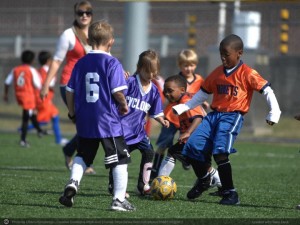Sports-related concussion is currently, arguably, the most heated topic in sports injury prevention. Sensationalist media headlines and stories about the toll of concussive hits, particularly in contact sports, are all-too-common. Recently, during the FIFA Women’s World Cup, we saw this head-knock between Alexandra Popp and Morgan Brian, which once again called into question protocols around the handling of suspected concussion in sports settings.
Concussion is known to be an important issue, and its prevention is of utmost importance for the health and safety of all those who play sport. A recent study monitored the number of people treated in hospital for sport-related concussion over a period of nine years in Victoria, Australia. It showed that more people are being hospitalised for sports-related concussion than in the past, but we don’t know why. We think that better healthcare, more people knowing about concussion and the importance of being monitored for symptoms, as well as changes in the way that sport is played could all have contributed to the increase.
Concussion recognition tools and management guidelines are available freely online: the Sideline Concussion Assessment Tool (SCAT3) and the Child SCAT3 are based on this International Conference on Concussion in Sport consensus statement.
The SCAT3 clearly states:
Any athlete with a suspected concussion should be removed from play, medically assessed, monitored for deterioration (i.e., should not be left alone) and should not drive a motor vehicle until cleared to do so by a medical professional. No athlete diagnosed with concussion should be returned to sports participation on the day of injury.
Yet, as is shown in the media and on our sports fields, more often than not this advice is not followed. It is true that general knowledge about concussion symptoms is good (and most people now understand that you do not need to be knocked ‘out cold’ to experience concussion), but knowledge about concussion management in sport settings is lagging.
A recent article published in Injury Prevention, An examination of concussion education programmes: a scoping review methodology showed that concussion guidelines effected:
short-term improvements in knowledge, attitudes and behaviours; however, the long-term benefits of concussion education programmes were less clear
It has been found that coaches and sports trainers tasked with concussion management do not yet know how to fully use concussion guidelines, even if they are aware of them being available. They need more education and hands-on practical experience. Asking a player if they want to play on after a head-knock is about as useful as a chocolate teapot. Whilst it may appear a common sense question at first, we just do not know enough about how potentially concussive head-knocks affect individuals, and as such cannot rely on the athlete with potential concussion to make such a call. It is vitally important that concussion management is addressed by sports governing bodies, put into operation by clubs, and handled correctly and ethically by team doctors, coaches, and sports trainers – for the ultimate welfare of athletes.
Research into the management of sports-related concussion can, and should, do more to effect change. Guidelines are necessary but insufficient. Conceiving injury prevention interventions differently by recognising the unique and nuanced challenges of sports culture – such as the win-at-all-costs attitude, and the celebration of hero-athletes returning to play – within complex sports settings is vital.
*Thanks Reidar Lystad for suggesting the chocolate teapot metaphor on twitter last night.
